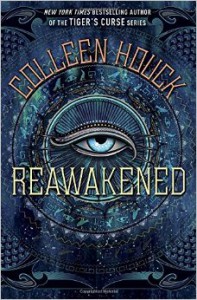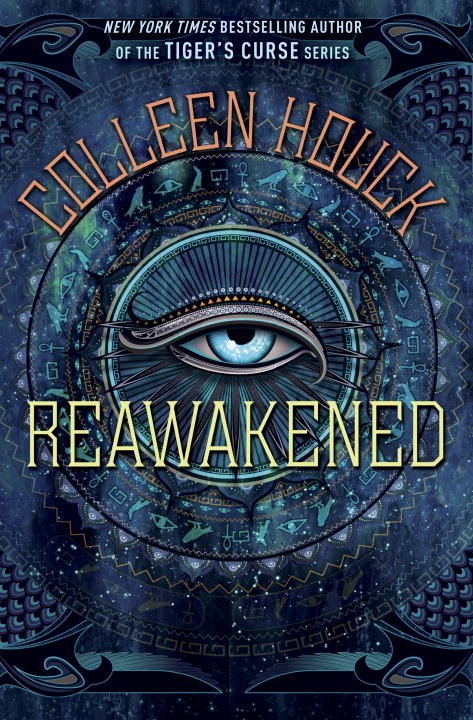Late last month, a new release from New York Times bestselling author of the Tiger’s Curse series, Colleen Houck, hit the shelves. Packed with action and adventure, Reawakened awakens the reader to diverse ways of being in the world and imparts considerable knowledge about Egyptian culture and history.
Houck’s book features image conscious, seventeen year old Lilliana Young who enjoys studying people. During spring break of her senior year, Lilliana is  trying to determine a career path. While psychology and counselling are likely choices, she knows her parents want her to major in something that would make them proud, like medicine, business, or politics. To weigh her options in a more serene setting, Lilliana takes a cab to the Metropolitan Museum of Art, one of her favorite hideouts.
trying to determine a career path. While psychology and counselling are likely choices, she knows her parents want her to major in something that would make them proud, like medicine, business, or politics. To weigh her options in a more serene setting, Lilliana takes a cab to the Metropolitan Museum of Art, one of her favorite hideouts.
At the Met, hoping for a quiet place to think, Lilliana secures the guard’s permission to slip under the fabric rope of the Egyptian exhibit, where the museum staff are adding some new pieces. Although no one else should be in the Egyptian wing, here she encounters an “otherworldly” handsome stranger seeking his jars of death. When he realizes his canopic jars are not in the museum, he surreptitiously borrows Lilliana’s life force, despite her efforts to defend herself with pepper spray. Although she eventually escapes the museum, she discovers that she is inexplicably bound to this specimen of physical splendor, and when he is later hit by “a golden chariot,” Lily is compelled to assist him. She learns that this powerful, model-tall, miracle man named Amon is desperate to reach Thebes to locate his brothers. As Amon—a mummy who has risen from his sarcophagus—unwraps the rest of his story, Lily learns of his history and his god-like status. Amon possesses power, a gift from the sun god Amun-Ra and his son Horus, whose eye allows him to see the truth. The Eye of Horus, featured in many works of art and carvings in Egypt, is an amulet for warding off evil, “shielding its bearer from harm. The symbol is [also] . . . a reminder that when we are stripped of all we hold dear, we can finally see the truth” (99). Each millennium as part of an ancient promise and prophecy, Amon rises to perform a ceremony—with the aid of his two brothers, Asten and Ahmose—that will save the world from chaos and keep the evil influence of Seth at bay. The trio are “warriors [and] divine protectors who aspire to fulfill their celestial calling” (252).
Because Amon depends on Lily more than she realizes and because Lily has more courage and pluck than she is willing to admit, Amon thinks Lily has the heart of a sphinx. Along for the transcontinental trek to Egypt, Lily begins to feel more alive, more real, and less like the porcelain doll her parents had molded her into. Because her bond with Amon draws her inner thoughts and feelings to the surface, Lily grows more aware. At Amon’s side, she tackles the ultimate adventure with ancient booby traps and experiences life in “all its sweaty, uncomfortable, harsh, heartbroken, scary, sometimes deadly, but always thrilling glory” (149).
Before meeting Amon, Lilliana doesn’t realize how trapped and lonely she has been; she never realized the weight of her structured life until it was gone. Because of her parents’ stern nature, she has learned to be careful and thoughtful about her choices in boyfriends and thinks love “looks like a “stiff upper lip of pride and approval” (9). Through Amon and her Egyptian experience, Lily realizes that her dream guy is sunny, committed, and attentive to the needs of others. To each, the other is temptation personified, and whether their destinies are meant for delight or for decadence will be the reader’s discovery.
Along with Lily, the reader learns many other lessons. One of those speaks to the human fear of risk-taking or leaving one’s comfort zone: “Even in the most dire of circumstances, it [is] better to live, explore, and face possible danger than to cower [for a lifetime] in a pretty box” (151). Another sheds light on faith: “Faith is merely a willingness to believe, and that belief becomes stronger and sharper over time until it can cut through your doubts” (252).
Besides these social and philosophical nuggets of wisdom, Houck imparts rich information about Egypt’s geography: the Valley of the Kings, Kom Ombo Temple, and the shores of the Nile are a few of the book’s settings. Readers further learn the stories of various Egyptian gods and goddesses: Anubis, Shu, Geb, Nut, Amun-Ra, Isis, Osiris, Horus, Apophis, and about Hatshepsut, a female pharoah who ruled Egypt for nearly 23 years, fostering the arts and erecting beautiful things. In telling her story, Houck artfully employs symbolism of water and birds (falcon, ibis, and crane) to convey meaning about creation, resurrection, and love destroyed. Replete with Egyptian lore, this book commemorates the history of a time lost and brings it back to life.
- Posted by Donna

